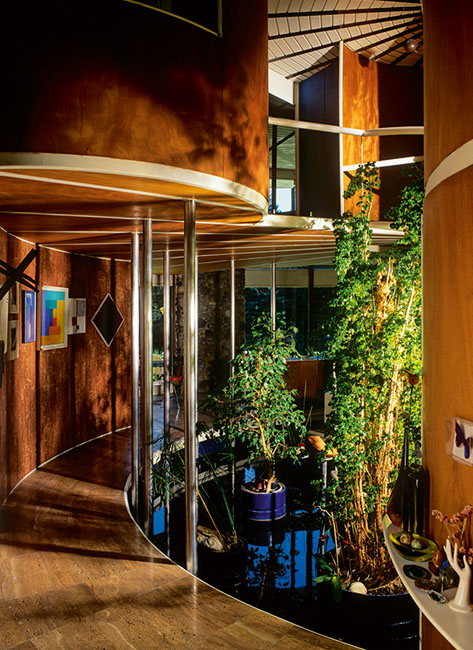Solarhaus Wermatswil
Otto Kolb
Abstract
Located in Wermatswil near Zurich is a round Solarhaus, the residence of architect Otto Kolb (1921-1996). This home, the last project he realized, reflects his radical ideas about housing and living in absolute harmony with nature. In a manuscript Kolb wrote about the house, he quotes the psychoanalyst Carl Jung: ‘The house of man should be round, to remember the protected mother’s lap (unconsciously the womb).’ Kolb goes on to say: ‘But this was not the only argument for making the house round. A circular shape has the smallest possible surface contact with the (cold) outdoor climate and the wind, and is capable of absorbing sunlight and heat the whole day long.’
The design follows the principle that there are no straight lines in nature; all of the rooms, as well as the façade, the garden and the swimming pool, have an ergonomic form. The basement is partially dug into a slope, and contains an office and a variety of technical spaces that serve the ecological principles of the house. The actual living area above it is two stories high and consists of a continuum of spaces. Immediately catching the eye at the centre of the house is a spiral staircase leading to the upper level: floating in the twostorey high space at different levels and connected by inclined walkways are the bedrooms, the bathroom and two workspaces from which there is an overall view of the living space on the lower level. Integrated into the staircase is a fireplace with a Wärmeluftkammer (hot air chamber), which, depending on the temperature of the fire, can be used for forced-air heating or underfloor heating. Ample sunlight comes into the house through two-storey high windows made of triple-layered glass, which offer a superb view of the nature around the house. As the windows cannot be opened, there is no heat loss. Six doors to the outside provide ventilation.
Several water basins form the core of the house’s energy management. The indoor pond and the outdoor swimming pool are not just aesthetically pleasing, but also regulate the micro climate in the dwelling. The water reservoir in the basement is heated by solar panels on the roof and serves as heat storage in the wintertime and provides air conditioning in the summertime. The water on the ground level is an indoor pond that is lushly planted, which also functions as a dust collector. The humid air produced by the indoor pond regulates the humidity in the house. Outdoors, on the south side of the house, is yet another water basin. Part of it is used as a swimming pool and the rest serves as a mirroring surface in order to catch and reflect the most advantageous amount of sunlight and heat. Where the façade does not consist of glass, the interior cavity wall is made of large stones found on the construction site. Behind it are the heating conduits, which are covered with a 7-cm-thick layer of glass wool insulation and steel sheeting, for the façade. The walls are heated by the sun in the daytime and by hot water from the basins at night.



